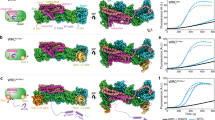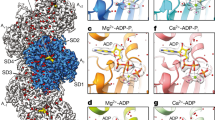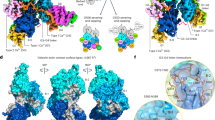Abstract
The Rho-family GTPase, Cdc42, can regulate the actin cytoskeleton through activation of Wiskott–Aldrich syndrome protein (WASP) family members. Activation relieves an autoinhibitory contact between the GTPase-binding domain and the carboxy-terminal region of WASP proteins. Here we report the autoinhibited structure of the GTPase-binding domain of WASP, which can be induced by the C-terminal region or by organic co-solvents. In the autoinhibited complex, intramolecular interactions with the GTPase-binding domain occlude residues of the C terminus that regulate the Arp2/3 actin-nucleating complex. Binding of Cdc42 to the GTPase-binding domain causes a dramatic conformational change, resulting in disruption of the hydrophobic core and release of the C terminus, enabling its interaction with the actin regulatory machinery. These data show that ‘intrinsically unstructured’ peptides such as the GTPase-binding domain of WASP can be induced into distinct structural and functional states depending on context.
This is a preview of subscription content, access via your institution
Access options
Subscribe to this journal
Receive 51 print issues and online access
$199.00 per year
only $3.90 per issue
Buy this article
- Purchase on SpringerLink
- Instant access to full article PDF
Prices may be subject to local taxes which are calculated during checkout





Similar content being viewed by others
References
Bourne, H. R., Sanders, D. A. & McCormick, F. The GTPase superfamily: a conserved switch for diverse cell functions. Nature 348, 125– 131 (1990).
Hall, A. Rho GTPases and the actin cytoskeleton. Science 279, 509–514 (1998).
Machesky, L. M. & Insall, R. H. Signaling to actin dynamics. J. Cell Biol. 146, 267– 272 (1999).
Derry, J. M. J., Ochs, H. D. & Francke, U. Isolation of a novel gene mutated in the Wiskott–Aldrich syndrome. Cell 78, 635– 644 (1994).
Burbelo, P. D., Drechsel, D. & Hall, A. A conserved binding motif defines numerous candidate target proteins for both Cdc42 and Rac GTPases. J. Biol. Chem. 270, 29071–29074 ( 1995).
Abdul-Manan, N. et al. Structure of Cdc42 in complex with the GTPase binding domain of the Wiskott–Aldrich syndrome protein. Nature 399, 379–383 (1999).
Miki, H. et al. Induction of filopodium formation by a WASP-related actin-depolymerizing protein N-WASP. Nature 391, 93– 96 (1998).
Rohatgi, R. et al. The interaction between N-WASP and the Arp2/3 complex links Cdc42-dependent signals to actin assembly. Cell 97, 221–231 (1999).
Rudolph, M. et al. The Cdc42/Rac interactive binding region motif of the Wiskott Aldrich syndrome protein (WASP) is necessary but not sufficient for tight binding to Cdc42 and structure formation. J. Biol. Chem. 273, 18067–18076 (1998).
Buck, M. Trifluoroethanol and colleagues: cosolvents come of age. Recent studies with peptides and proteins. Quart. Rev. Biophys. 31, 297–355 (1998).
Cornilescu, G., Delaglio, F. & Bax, A. Protein backbone angle restraints from searching a database for chemical shift and sequence homology. J. Biomol. NMR 13, 289–302 (1999).
Rohl, C. A., Chakrabartty, A. & Baldwin, R. L. Helix propagation and N-cap propensities of the amino acids measured in alanine-based peptides in 40 volume precent trifluoroethanol. Protein Sci. 5, 2623–2637 (1996).
Machesky, L. M. et al. Scar, a WASp-related protein, activates nucleation of actin filaments by the Arp2/3 complex. Proc. Natl Acad. Sci. USA 96, 3739–3744 (1999).
Winter, D., Lechler, T. & Li, R. Activation of the yeast Arp2/3 complex by Bee1p, a WASP-family protein. Curr. Biol. 9, 501–504 ( 1999).
Yarar, D. et al. The Wiskott–Aldrich syndrome protein directs actin-based motility by stimulating actin nucleation with the Arp2/3 complex. Curr. Biol. 9, 555–558 ( 1999).
Bi, E. & Zigmond, S. H. Actin polymerization: where the WASP stings. Curr. Biol. 9, R160– R163 (1999).
Sharman, G. J. & Searle, M. S. Cooperative interaction between the three strands of a designed antiparallel β-sheet. J. Am. Chem. Soc. 120, 5291– 5300 (1998).
Oda, A. et al. Collagen induces tyrosine phosphorylation of Wiskott–Aldrich syndrome protein in human platelets. Blood 92, 1852–1858 (1998).
Baba, Y. et al. Involvement of Wiskott–Aldrich syndrome protein in B-cell cytoplasmic tyrosine kinase pathway. Blood 93, 2003–2012 (1999).
Guinamard, R. et al. Tyrosine phosphorylation of the Wiskott–Aldrich syndrome protein by Lyn and Btk regulated by CDC42. FEBS Lett. 434, 431–436 (1998).
Kwan, S. et al. Scanning of the Wiskott–Aldrich syndrome (WAS) gene: identification of 18 novel alternations including a possible mutation hotspot at ARG86 resulting in thrombocytopenia, a mild WAS phenotype. Hum. Mol. Genet. 4, 1995–1998 (1995).
Villa, A. et al. X-Linked thrombocytopenia and Wiskott–Aldrich syndrome are allelic diseases with mutations in the WASP gene. Nature Genet. 9, 414–417 ( 1995).
Shcherbina, A., Rosen, F. S. & Remold-O'Donnell, E. WASP levels in platelets and lymphocytes of Wiskott–Aldrich syndrome patients correlate with cell dysfunction. J. Immunol. 163, 6314–6320 ( 1999).
Derry, J. M. J. et al. WASP gene mutations in Wiskott–Aldrich syndrome and X-linked thrombocytopenia. Hum. Mol. Genet. 4, 1127–1135 (1995).
Kolluri, R. et al. Identification of WASP mutations in patients with Wiskott–Aldrich syndrome and isolated thrombocytopenia reveals allelic heterogeneity at the WAS locus. Hum. Mol. Genet. 4, 1119– 1126 (1995).
Block, C. et al. Quantitative structure-activity analysis correlation Ras/Raf interaction in vitro to Raf activation in vivo. Nature Struct. Biol. 3, 244–251 ( 1996).
Campbell, S. et al. Increasing complexity of Ras signaling. Oncogene 17, 1395–1413 ( 1998).
Zhao, Z. S. et al. A conserved negative regulatory region in alphaPAK: inhibition of PAK kinases reveals their morphological roles downstream of Cdc42 and Rac1. Mol. Cell. Biol. 18, 2153– 2163 (1998).
Manser, E. et al. A brain serine/threonine protein kinase activated by Cdc42 and Rac1. Nature 367, 40– 46 (1994).
Stokoe, D. et al. Activation of Raf as a result of recruitment to the plasma membrane. Science 264, 1463– 1467 (1994).
Spolar, R. S. & Record, M. T. Jr Coupling of local folding to site-specific binding of proteins to DNA. Science 263, 777–784 (1994).
Wright, P. E. & Dyson, H. J. Intrinsically unstructured proteins: re-assessing the protein structure- function paradigm. J. Mol. Biol. 293, 321–331 ( 1999).
Yamazaki, T. et al. A suite of triple resonance NMR experiments for the backbone assignment of 15N, 13C,2H labeled proteins with high sensitivity. J. Am. Chem. Soc. 116 , 11655–11666 (1994).
Logan, T. M. et al. A general method for assigning NMR spectra of denatured proteins using 3D HC(CO)NH-TOCSY triple resonance experiments. J. Biomol. NMR 3, 225–231 ( 1993).
Kay, L. E. et al. A gradient-enhanced HCCH-TOCSY experiment for recording side-chain proton and carbon-13 correlations in water samples of proteins. J. Magn. Reson. Ser. B 101, 333–337 (1993).
Kuboniwa, H. et al. Measurement of HN-H alpha J couplings in calcium-free calmodulin using new 2D and 3D water-flip-back methods. J. Biomol. NMR 4, 871–878 (1994).
Neri, D. et al. Stereospecific nuclear magnetic resonance assignments of the methyl groups of valine and leucine in the DNA-binding domain of the 434 repressor by biosynthetically directed fractional 13C labeling. Biochemistry 28, 7510–7516 (1989).
Farrow, N. A. et al. Backbone dynamics of a free and phosphopeptide-complexed Src homology 2 domain studied by 15N NMR relaxation. Biochemistry 33, 5984–6003 (1994).
Brunger, A. T. et al. Crystallography & NMR system: a new software suite for macromolecular structure determination. Acta Crystallogr. D 54, 905–921 (1998).
Nilges, M. et al. Automated NOESY interpretation with ambiguous distance restraints: the refined NMR solution structure of the pleckstrin homology domain from beta-spectrin. J. Mol. Biol. 269, 408– 422 (1997).
Brünger, A. T. X-PLOR manual. (Yale Univ. Press, New Haven, 1993).
Laskowski, R. A. et al. AQUA and PROCHECK-NMR: programs for checking the quality of protein structures solved by NMR. J. Biomol. NMR 8, 477–486 (1996).
Carson, M. J. Ribbons 2. 0. J. Appl. Crystallogr. 24, 958–961 (1991).
Nicholls, A., Sharp, K. A. & Honig, B. Protein folding and association: insights from the interfacial and thermodynamic properties of hydrocarbons. Proteins Struct. Funct. Genet. 11, 281–296 (1991).
Acknowledgements
We thank M. Lu for analytical ultracentrifugation experiments; W. Hu for communicating results before publication; M. Buck, Y.M. Chook, J. Goldberg, B. Schulman, B. W. Trotter and M. R. Wood for discussion and critical reading of the manuscript; R. Cerione and K. Siminovitch for providing cDNAs for Cdc42 and WASP, respectively; L. Kay for providing many of the NMR pulse sequences used in this study; F. Delaglio for providing nmrPipe and TALOS software; A. Majumdar, W. Hu and B. Aghazadeh for assistance in NMR data acquisition; J. Hubbard for computer system support and M. Fiore for expert administrative assistance. A.S.K. is supported by a fellowship from the Damon Runyon-Walter Winchell Foundation, and L.T.K. by the Charles H. Revson Foundation. M.K.R. acknowledges support from the NIH (PECASE program), Arnold and Mabel Beckman Foundation, and Sidney Kimmel Foundation for Cancer Research.
Author information
Authors and Affiliations
Corresponding author
Rights and permissions
About this article
Cite this article
Kim, A., Kakalis, L., Abdul-Manan, N. et al. Autoinhibition and activation mechanisms of the Wiskott–Aldrich syndrome protein. Nature 404, 151–158 (2000). https://doi.org/10.1038/35004513
Received:
Accepted:
Issue Date:
DOI: https://doi.org/10.1038/35004513
This article is cited by
-
A single chlamydial protein reshapes the plasma membrane and serves as recruiting platform for central endocytic effector proteins
Communications Biology (2023)
-
Increased cross-presentation by dendritic cells and enhanced anti-tumour therapy using the Arp2/3 inhibitor CK666
British Journal of Cancer (2023)
-
Impact of the Synthetic Scaffold Strategy on the Metabolic Pathway Engineering
Biotechnology and Bioprocess Engineering (2023)
-
Gastrointestinal Disorders Associated with Primary Immunodeficiency Diseases
Clinical Reviews in Allergy & Immunology (2019)
-
Regulation of MRTF-A by JMY via a nucleation-independent mechanism
Cell Communication and Signaling (2018)



